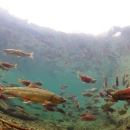Over 40 years after the last bull trout (Salvelinus confluentus) was documented in the Clackamas River in 1963, a 2007 feasibility study determined the Clackamas River Subbasin to be a promising candidate for bull trout reintroduction. A reintroduction effort began in 2011, with the goal of re-establishing a self-sustaining population of spawning adults (between 300 and 500) by the year 2030. The final year of translocating bull trout from the Metolius River Subbasin to designated locations in the upper Clackamas River and select tributaries was 2016. The seventh year of the project marks the beginning of the second phase where the primary objectives were to monitor and evaluate the reintroduction effort. During 2017, progress has continued to be made toward the project’s goal. The effectiveness of the reintroduction strategy was assessed by describing the seasonal distribution of translocated bull trout, assessing reproduction, and characterizing potential impacts to Endangered Species Act-listed salmon and steelhead that currently occupy the Clackamas River Subbasin. A video monitoring weir with an associated adult trap and passive integrated transponder (PIT) antenna was employed in Pinhead Creek to assess the spawning population. The spawning population was comprised of translocated individuals released at every lifestage during the years of 2012 – 2016, confirming survival and recruitment into the adult population. The 34 individuals subsampled at the weir trap were relatively large, migratory fish and ranged in size from 462 – 653 mm TL. Of the bull trout observed at the weir, 92% of males and 55% of females were previously PIT-tagged. Since all translocated fish were PIT-tagged, the presence of untagged fish suggests at least some of the spawners may be naturally produced offspring, though the disparity between the ratio of tagged to untagged males and females may indicate an elevated rate of tag shedding in females. There were six translocated fish with PIT detection histories that suggested a possible resident component of the Pinhead Creek population. The number of bull trout using Pinhead Creek during the spawning season has increased since the early years of the reintroduction effort. We estimated nearly 100 individuals in 2017, and redd counts throughout the study area reached their highest (N = 89) since the initiation of the reintroduction effort. In addition, in 2017 we confirmed multiple bull trout redds in Pinhead Creek resulted in viable embryos and hatching (i.e., alevins). However, monitoring efforts have not provided evidence of post-emergent juveniles, or confirmed the recruitment of naturally-reproduced individuals into the spawning population, both of which are major benchmarks in the overall goal of establishing a self-sustaining population of bull trout in the Clackamas River Subbasin. These benchmarks may be achieved over time as the reintroduction effort progresses and the population develops. Implementation and monitoring of the reintroduction project will continue to be evaluated on an annual basis and the reintroduction strategy will be adaptively managed.
Publication date
Type of document
Report
Facility
Program
Species
FWS Focus
Ecosystem
FWS and DOI Region(s)








